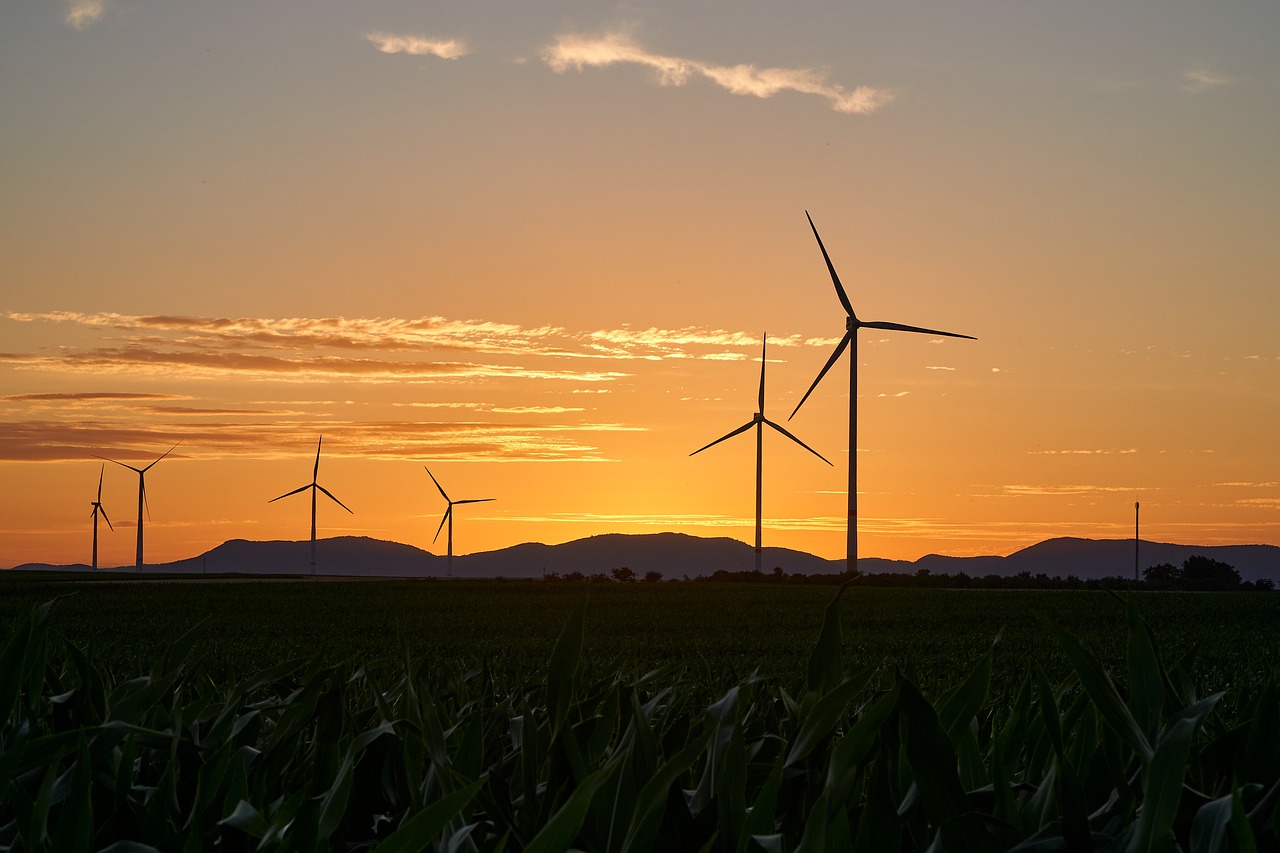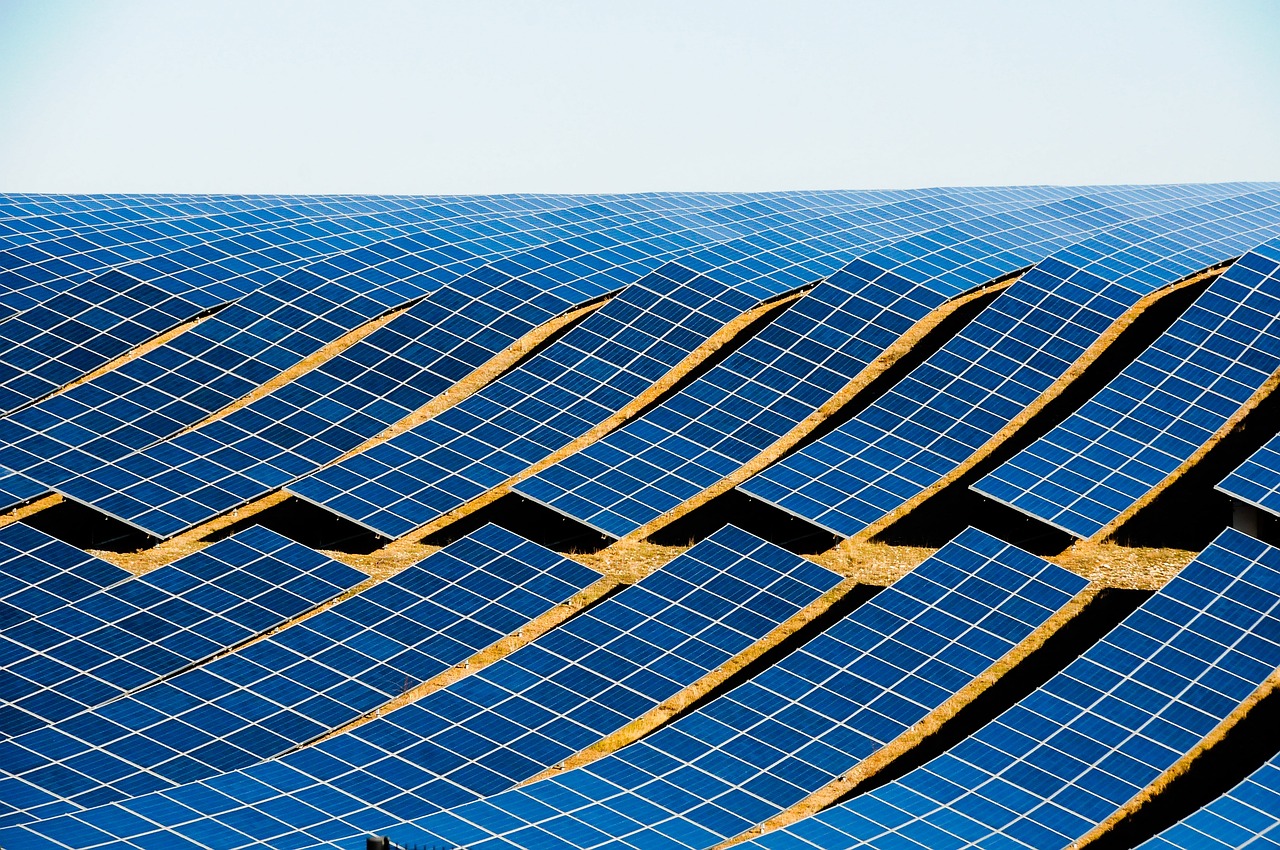Green Energy – Is there a Risk of Resource Depletion?
As we move towards a more sustainable future, the concept of green energy has taken center stage. But amidst the excitement and optimism, a pressing question arises: Is there a risk of resource depletion? This article delves deep into the potential risks associated with the materials that power our renewable energy technologies, exploring sustainability, environmental impacts, and what the future holds for renewable energy sources.
Green energy refers to renewable energy sources that have a minimal environmental impact. These sources are pivotal in combating climate change and reducing our carbon footprint. They include solar, wind, hydro, and geothermal energy, all of which harness natural processes to generate power. By utilizing these resources, we can significantly decrease our reliance on fossil fuels, which are finite and damaging to our planet. The importance of green energy cannot be overstated; it represents a shift towards a cleaner, more sustainable energy landscape that can help mitigate the effects of global warming.
There are various types of green energy sources, each with its unique characteristics and benefits. Here’s a brief overview:
- Solar Energy: Harnesses sunlight through photovoltaic cells or solar thermal systems.
- Wind Energy: Captures the kinetic energy of wind through turbines.
- Hydro Energy: Utilizes flowing water to generate electricity.
- Geothermal Energy: Taps into the Earth’s internal heat for power and heating.
Each of these sources plays a crucial role in the energy landscape, contributing to a diversified and resilient energy portfolio.
Solar energy has gained immense popularity in recent years, and for good reason. By harnessing sunlight, we can produce clean electricity without emitting greenhouse gases. However, it’s essential to consider the challenges that come with it. For instance, the manufacturing of solar panels requires various materials, some of which are rare and can be environmentally taxing to extract. As we push for widespread adoption, we must ask ourselves: Can we sustainably scale up solar energy production without depleting our resources? The potential for solar energy is vast, but it must be approached with caution and care.
Wind energy is another powerhouse in the realm of renewable energy. By capturing the kinetic energy of wind through turbines, we can generate significant amounts of electricity. However, geographical limitations can pose challenges; not every location is suitable for wind farms. Additionally, advancements in technology are continually enhancing efficiency, making wind energy a more viable option. Still, we must consider the environmental impact of turbine installations and the materials required for their construction. Are we prepared to balance these factors as we expand our wind energy capabilities?
The extraction of materials for renewable technologies raises important sustainability concerns. Mining for the resources needed to build solar panels, wind turbines, and batteries can have detrimental effects on local ecosystems and communities. As we transition to green energy, we must critically analyze the environmental impact of these practices. The question looms large: Are we trading one form of environmental degradation for another? Understanding the lifecycle of these materials—from extraction to disposal—is crucial for ensuring that our green energy solutions are genuinely sustainable.
Rare earth metals are crucial for the manufacturing of many green technologies, including batteries and electric vehicles. However, the extraction of these metals poses significant risks. Mining activities can lead to habitat destruction, soil and water pollution, and health hazards for nearby communities. As we embrace green technologies, we must also consider the implications of rare earth metal extraction. Are we prepared to face the consequences of resource depletion in our quest for sustainability?
One of the most effective strategies to mitigate resource depletion is through recycling and reusing materials. By improving the lifecycle of materials used in green energy technologies, we can reduce the demand for new resources and minimize environmental impact. Initiatives aimed at recycling old solar panels and wind turbine components are gaining traction, and it's crucial to promote these practices. How can we create a circular economy that supports sustainable energy production? This is a challenge that requires innovative thinking and collaboration across industries.
While green energy is essential for sustainability, its implementation can impact local ecosystems. The construction of solar farms and wind turbines can disrupt habitats, leading to potential declines in biodiversity. We must carefully evaluate the potential effects of renewable energy projects on local wildlife and ecosystems. Balancing the need for clean energy with the preservation of biodiversity is a delicate yet necessary task.
As technology evolves, so do the strategies for harnessing green energy. Emerging trends, such as advancements in energy storage and smart grid technology, promise to reduce resource depletion risks while promoting sustainability. Innovations in material science may lead to more efficient and less resource-intensive methods for producing green technologies. The future of green energy is bright, but it requires a commitment to sustainable practices and continuous improvement.
In conclusion, the transition to green energy must consider resource depletion. As we explore the benefits of renewable energy sources, it's imperative to remain vigilant about the sustainability of the materials we use. By prioritizing recycling, responsible extraction, and technological innovation, we can create a greener future without sacrificing our planet’s precious resources. Let’s embrace the challenge and strive for a harmonious balance between energy needs and resource conservation.
- What is green energy?
- Green energy refers to renewable energy sources that have a minimal environmental impact, such as solar, wind, hydro, and geothermal energy.
- Are there risks associated with green energy?
- Yes, while green energy is more sustainable than fossil fuels, the extraction of materials for renewable technologies can lead to environmental degradation and resource depletion.
- How can we mitigate resource depletion in green energy?
- Recycling and reusing materials, responsible mining practices, and advancements in technology can help mitigate resource depletion risks.

Understanding Green Energy
Green energy is more than just a buzzword; it's a movement aimed at harnessing natural resources to create energy with minimal environmental impact. Unlike traditional fossil fuels, which emit harmful pollutants and contribute to climate change, green energy sources are sustainable and renewable. They play a crucial role in reducing our carbon footprint and combating global warming. But what exactly constitutes green energy, and why is it so important in today's world?
At its core, green energy encompasses various forms of energy derived from natural processes that are continuously replenished. This includes sources such as solar, wind, hydroelectric, geothermal, and biomass. Each of these sources has unique characteristics and benefits, but they all share a common goal: to provide clean energy without depleting the planet's resources.
One of the most compelling reasons to transition to green energy is its potential to significantly reduce greenhouse gas emissions. For instance, did you know that solar energy can reduce emissions by up to 90% compared to coal? This drastic reduction is vital in our fight against climate change. Additionally, green energy can enhance energy security by diversifying energy sources, making countries less reliant on imported fuels.
Moreover, investing in green energy technologies can create jobs and stimulate economic growth. As the demand for renewable energy solutions increases, so does the need for skilled labor in installation, maintenance, and research and development. This shift not only helps the environment but also boosts local economies, creating a win-win situation for communities worldwide.
However, it's essential to recognize that the transition to green energy is not without its challenges. For instance, while solar and wind energy are abundant, they are also intermittent, meaning they are not always available when demand is high. This necessitates the development of energy storage solutions and a more resilient energy grid to ensure a steady supply. Additionally, the extraction of materials for renewable technologies, such as batteries and solar panels, raises sustainability concerns that need to be addressed.
In summary, understanding green energy is crucial for anyone interested in the future of our planet. It's not just about switching off the lights or using less energy; it's about embracing a holistic approach to energy consumption and production. By prioritizing renewable resources, we can pave the way for a sustainable future, ensuring that generations to come can enjoy a healthy planet.
Frequently Asked Questions
- What is green energy? Green energy refers to renewable energy sources that have minimal environmental impact, such as solar, wind, and hydroelectric power.
- Why is green energy important? It helps reduce greenhouse gas emissions, combat climate change, and promote energy independence.
- What are the challenges of green energy? Challenges include intermittency of energy supply, resource extraction impacts, and the need for improved energy storage and grid infrastructure.

Types of Green Energy Sources
When we talk about green energy, we're diving into a world of renewable resources that promise a cleaner, more sustainable future. But what exactly are these sources? In essence, green energy comes from natural processes that are replenished constantly. Unlike fossil fuels, which can take millions of years to form and are finite, green energy sources are abundant and available in various forms. Let's explore some of the most prominent types of green energy sources that are shaping our energy landscape today.
First up, we have solar energy. This remarkable energy source captures sunlight through photovoltaic cells or solar thermal systems. Imagine the sun shining down on your roof, powering your home with clean energy! Solar panels convert sunlight into electricity, making it a fantastic option for residential and commercial use. With advancements in technology, solar energy has become increasingly efficient and affordable, allowing more people to harness its power. However, challenges like energy storage and land use must be addressed to maximize its potential.
Next on our list is wind energy. Wind turbines, often seen gracefully spinning on hillsides or offshore, convert the kinetic energy of wind into electricity. This energy source is incredibly effective in regions with consistent winds, such as coastal areas. However, it does come with its own set of geographical limitations; not every location is suitable for wind farms. Despite these challenges, innovations in turbine design and placement are continually enhancing the efficiency and output of wind energy, making it a vital player in the green energy arena.
Hydropower is another significant contributor to the green energy mix. By harnessing the flow of water in rivers and streams, hydropower plants convert the energy of moving water into electricity. This method has been used for centuries, but modern technology has made it more efficient and less intrusive. However, the construction of large dams can disrupt local ecosystems and fish populations, raising concerns about biodiversity. Therefore, smaller-scale hydro projects are gaining popularity as a more sustainable alternative.
Lastly, we can't forget about geothermal energy. This lesser-known source taps into the Earth's internal heat, providing a constant and reliable energy source. By drilling deep into the Earth, we can access steam and hot water to generate electricity or provide direct heating. Geothermal energy is particularly effective in volcanic regions, where the Earth's heat is more accessible. However, the initial costs of drilling and infrastructure can be high, which may deter some investors.
In summary, the world of green energy is diverse and full of potential. Each source has its unique advantages and challenges, but together, they offer a pathway to a more sustainable future. As we continue to innovate and improve these technologies, the prospect of a greener planet becomes more attainable.
- What is green energy? Green energy refers to renewable energy sources that have a minimal environmental impact, such as solar, wind, hydro, and geothermal energy.
- How does solar energy work? Solar energy harnesses sunlight through photovoltaic cells or solar thermal systems to generate electricity or heat.
- What are the environmental impacts of wind energy? While wind energy is clean, its installation can affect local wildlife and ecosystems, particularly in areas where turbines are placed.
- Can hydropower affect fish populations? Yes, large dams can disrupt fish migration patterns, but smaller hydro projects are designed to minimize these impacts.
- Is geothermal energy sustainable? Yes, geothermal energy is considered sustainable as it relies on the Earth’s internal heat, which is continuously replenished.

Solar Energy
Solar energy is one of the most promising forms of green energy, harnessing the abundant power of the sun to generate electricity and heat. Imagine a world where sunlight is not just a source of light but a vital energy provider—this is the potential that solar energy holds. By utilizing photovoltaic cells or solar thermal systems, we can convert sunlight directly into usable energy. This technology has evolved significantly over the years, making solar panels more efficient and affordable, thus paving the way for widespread adoption.
One of the most significant benefits of solar energy is its sustainability. Unlike fossil fuels, which are finite and contribute to greenhouse gas emissions, solar energy is virtually limitless and produces no emissions during operation. This characteristic makes it a crucial player in the fight against climate change. However, it’s essential to consider the challenges associated with solar energy. For instance, the efficiency of solar panels can be affected by geographical location, weather conditions, and the time of day. In regions with less sunlight, energy production can be significantly lower, leading to concerns about energy reliability.
Moreover, the installation of solar panels requires a considerable amount of space, which can lead to land-use conflicts, especially in densely populated areas. This brings us to the environmental impact of solar energy. While generating energy from sunlight is clean, the production and disposal of solar panels involve resource extraction and manufacturing processes that can harm the environment. For example, the mining of materials like silicon, silver, and other metals used in solar panels can lead to habitat destruction and pollution.
Despite these challenges, the potential for solar energy is enormous. Innovations in technology are continually improving the efficiency of solar panels and reducing costs. For instance, new materials such as perovskite solar cells promise to enhance energy conversion rates while being cheaper to produce. Additionally, advancements in energy storage solutions, like batteries, are addressing the intermittency issues associated with solar energy, allowing for energy to be stored and used when the sun isn’t shining.
To further understand the impact of solar energy, let's take a look at some key statistics:
| Year | Global Solar Capacity (GW) | Growth Rate (%) |
|---|---|---|
| 2010 | 40 | N/A |
| 2015 | 227 | 467.5 |
| 2020 | 773 | 240.5 |
| 2023 | 1,200 (estimated) | 55 |
This table illustrates the exponential growth of solar capacity worldwide, indicating a strong shift towards renewable energy sources. As we continue to innovate and invest in solar technology, we can expect to see even more remarkable advancements that will help mitigate the risks of resource depletion while maximizing the benefits of solar energy.
In summary, solar energy stands out as a beacon of hope in the quest for sustainable energy solutions. With its myriad benefits and ongoing technological advancements, it holds the key to a cleaner, greener future. However, it’s crucial to remain aware of the challenges it poses, particularly concerning resource extraction and environmental impact. By addressing these issues head-on, we can harness the full potential of solar energy while ensuring a sustainable approach to our energy needs.
- What are photovoltaic cells? Photovoltaic cells are devices that convert sunlight directly into electricity using semiconductor materials.
- How does solar energy impact the environment? While solar energy is clean during operation, its production and disposal can have environmental impacts due to resource extraction and manufacturing processes.
- What are the benefits of solar energy? Solar energy is renewable, reduces greenhouse gas emissions, and can lead to lower energy bills for consumers.
- Can solar energy be stored for later use? Yes, advancements in battery technology allow for the storage of solar energy, making it usable even when the sun isn’t shining.

Wind Energy
Wind energy is one of the most promising forms of renewable energy, harnessing the natural power of the wind to generate electricity. Imagine standing on a hilltop, feeling the cool breeze on your face, knowing that this very wind could power your home. It's fascinating, right? Wind energy captures the kinetic energy of moving air through large turbines that convert this energy into electricity. As we look around, we see wind farms sprouting up across the landscape, transforming the way we think about energy production.
One of the key benefits of wind energy is its **sustainability**. Unlike fossil fuels, wind is an abundant and inexhaustible resource. Once a wind turbine is operational, it produces energy without emitting harmful greenhouse gases, making it a vital player in the fight against climate change. Furthermore, wind energy can significantly reduce our reliance on non-renewable energy sources, which is a win-win for both the planet and our wallets.
However, the journey of wind energy isn't without its challenges. For instance, the effectiveness of wind energy generation is highly dependent on geographical location. Areas with consistent and strong winds are ideal for wind farms, but not every region is blessed with such conditions. This geographical limitation can lead to uneven energy distribution, creating a need for extensive infrastructure to transport energy from windy areas to urban centers.
Moreover, advancements in technology are constantly enhancing the efficiency of wind energy. Modern wind turbines are designed to be taller and more efficient than their predecessors, allowing them to capture more wind energy even at lower wind speeds. For example, the latest turbine models can generate power at wind speeds as low as 3 meters per second, which opens up new potential sites for wind farms.
Yet, while we celebrate the benefits of wind energy, we must also consider its impact on local ecosystems. The construction of wind farms can disrupt wildlife habitats and migratory patterns. Birds and bats are particularly vulnerable, as they may collide with turbine blades. This raises essential questions about how we can balance the need for renewable energy with the preservation of biodiversity. It's crucial that future wind energy projects incorporate environmental assessments to minimize their ecological footprint.
In summary, wind energy presents a remarkable opportunity for sustainable energy production. Its ability to generate clean electricity while reducing greenhouse gas emissions is invaluable. However, we must remain vigilant about the environmental implications and work towards solutions that prioritize both energy needs and ecological conservation. As we look to the future, the integration of wind energy into our overall energy strategy is not just an option; it’s a necessity.
- What are the main advantages of wind energy? Wind energy is renewable, reduces greenhouse gas emissions, and can lead to lower electricity costs.
- Are there any disadvantages to wind energy? Yes, it can be geographically limited, and there are concerns about its impact on wildlife.
- How do wind turbines work? Wind turbines convert the kinetic energy of wind into mechanical energy, which is then transformed into electricity.
- Can wind energy be stored for later use? Yes, advancements in battery technology are making it possible to store excess wind energy for later use.

Resource Extraction and Sustainability
When we talk about green energy, we often envision a world powered by clean, renewable sources that promise to reduce our carbon footprint and combat climate change. However, there’s an underlying complexity that often gets overlooked: the resource extraction required to produce these technologies. While renewable energy sources like solar panels and wind turbines seem like a step in the right direction, the materials needed to create them can pose significant sustainability challenges.
To put it simply, the extraction of materials such as metals and minerals for green technologies can lead to environmental degradation. Mining operations can disrupt local ecosystems, pollute water sources, and contribute to soil erosion. Moreover, the demand for these resources is increasing as we ramp up our efforts to transition to renewable energy. This raises an essential question: are we trading one problem for another?
For instance, consider the extraction of rare earth metals, which are crucial for the manufacturing of many green technologies. These metals are not just rare in terms of availability; their extraction often involves environmentally harmful processes that can devastate the surrounding landscape. The irony is that while we strive to create a sustainable energy future, we may inadvertently be causing significant harm to the environment through the very processes we rely on.
Furthermore, the lifecycle of materials used in green energy technologies is another critical aspect of sustainability. Once these materials are extracted, they must be processed, transported, and eventually disposed of or recycled. This lifecycle can contribute to a considerable carbon footprint, which contradicts the very purpose of adopting renewable energy. Therefore, it’s essential to consider how we can improve the sustainability of these processes.
To mitigate the risks associated with resource extraction, we can adopt several strategies:
- Responsible Mining Practices: Implementing eco-friendly mining techniques that minimize environmental impact.
- Recycling of Materials: Developing robust recycling programs to reclaim materials from old technologies.
- Alternative Materials: Researching and investing in alternative materials that can replace rare earth metals in certain applications.
As we delve deeper into the world of green energy, it’s crucial to understand that sustainability isn’t just about the energy we produce; it’s also about the resources we consume. By addressing the challenges associated with resource extraction, we can pave the way for a truly sustainable energy future that doesn’t compromise our planet’s health.
Q: What are the main materials needed for green energy technologies?
A: Key materials include solar cells (which often contain silicon), wind turbine components (like steel and rare earth metals), and batteries (which require lithium and cobalt).
Q: How can we make resource extraction more sustainable?
A: By implementing responsible mining practices, investing in recycling technologies, and exploring alternative materials, we can reduce the environmental impact of resource extraction.
Q: What is the impact of rare earth metal mining?
A: Rare earth metal mining can lead to significant environmental degradation, including habitat destruction, water pollution, and soil erosion.
Q: Are there alternatives to rare earth metals?
A: Yes, researchers are exploring alternative materials and technologies that can reduce or eliminate the need for rare earth metals in various applications.

Rare Earth Metals
Rare earth metals are a group of 17 elements that play a pivotal role in the production of many green technologies, including batteries, wind turbines, and solar panels. These metals, such as neodymium, dysprosium, and lithium, are not actually "rare" in the traditional sense; rather, they are often found in low concentrations, making their extraction challenging and environmentally taxing. The demand for these metals has skyrocketed in recent years due to the global push for renewable energy and electric vehicles. But as we delve deeper into the world of rare earth metals, we must ask ourselves: are we risking resource depletion in our quest for a greener planet?
The extraction of rare earth metals typically involves mining operations that can lead to significant environmental degradation. The process often requires large amounts of water and can result in the contamination of local ecosystems. For instance, the mining of these metals can generate toxic waste, which poses a risk not only to wildlife but also to human populations living nearby. This raises a critical question: is the environmental cost of extracting rare earth metals worth the benefits they provide in renewable energy technologies?
Moreover, the geopolitical landscape surrounding rare earth metals adds another layer of complexity. A significant portion of the world's supply is concentrated in a few countries, particularly China, which has led to concerns about supply chain stability and ethical sourcing. As nations scramble to secure their access to these crucial resources, the potential for conflict increases. To mitigate these risks, many experts advocate for the development of sustainable mining practices and the exploration of alternative materials that could reduce our reliance on rare earth metals.
One promising solution to the challenges posed by rare earth metals is the concept of recycling. By reclaiming and reusing these materials from old electronics and renewable energy systems, we can significantly reduce the need for new mining operations. The recycling process not only conserves resources but also minimizes the environmental impact associated with extraction. Here are some strategies that can help improve the lifecycle of rare earth metals:
- Developing Efficient Recycling Technologies: Investing in advanced recycling methods can enhance the recovery rates of rare earth metals from discarded products.
- Promoting Circular Economy Practices: Encouraging manufacturers to design products with recyclability in mind can facilitate easier recovery of these metals.
- Educating Consumers: Raising awareness about the importance of recycling electronics can lead to increased participation in recycling programs.
In conclusion, while rare earth metals are essential for the advancement of green technologies, their extraction poses significant sustainability challenges. As we forge ahead in our transition to renewable energy, it is crucial to balance our energy needs with responsible resource management. By investing in recycling and sustainable mining practices, we can help ensure that the drive for green energy does not come at the expense of our planet's resources.
1. What are rare earth metals?
Rare earth metals are a group of 17 elements that are vital in the production of various technologies, especially in renewable energy applications.
2. Why are rare earth metals important for green energy?
They are crucial for manufacturing components in renewable energy technologies, such as batteries for electric vehicles and magnets for wind turbines.
3. What are the environmental impacts of extracting rare earth metals?
The extraction process can lead to significant environmental degradation, including habitat destruction and water contamination.
4. How can recycling help with rare earth metal depletion?
Recycling can reclaim valuable materials from old electronics, reducing the need for new mining and minimizing environmental impact.
5. Where are the majority of rare earth metals sourced from?
A large portion of rare earth metals is sourced from China, which raises concerns about supply chain stability and ethical sourcing.

Recycling and Reuse
In our quest for a sustainable future, have emerged as powerful allies in combating the potential risks of resource depletion associated with green energy technologies. Imagine for a moment the amount of energy and resources that go into producing solar panels, wind turbines, and batteries for electric vehicles. Now, think about the impact if we could harness those materials again and again through effective recycling practices. Not only does this approach help preserve our planet's finite resources, but it also significantly reduces the environmental footprint of manufacturing new products.
When we talk about recycling, we refer to a process that transforms waste materials into reusable resources. This not only diverts waste from landfills but also conserves the energy that would have been expended in extracting new raw materials. For instance, recycling aluminum saves up to 95% of the energy required to produce new aluminum from ore. Similarly, recycling rare earth metals, which are essential for many green technologies, can mitigate the need for extensive mining operations that often result in environmental degradation.
Moreover, the concept of reuse goes hand in hand with recycling. It encourages us to rethink our consumption habits. Instead of discarding old devices, we can refurbish them or repurpose their components for new applications. This not only extends the lifecycle of materials but also fosters a culture of sustainability. For example, the batteries used in electric vehicles can be repurposed for energy storage in homes, providing a second life to technologies that would otherwise be deemed obsolete.
To illustrate the importance of recycling and reuse in the context of green energy, consider the following table that highlights various materials used in renewable technologies and their recycling potential:
| Material | Application | Recycling Potential |
|---|---|---|
| Solar Panels | Photovoltaic systems | Up to 90% recyclable |
| Wind Turbines | Turbine blades | 50% recyclable (with ongoing research for improvement) |
| Electric Vehicle Batteries | Energy storage | 95% recyclable |
| Rare Earth Metals | Magnets in motors | Up to 70% recyclable |
As we move forward, integrating recycling and reuse into our green energy strategies will be crucial. Governments, industries, and consumers must collaborate to create robust recycling programs that not only focus on the end-of-life phase of products but also emphasize design for disassembly and material recovery from the outset. By fostering a circular economy, we can ensure that the materials crucial for green technologies are kept in use, thereby reducing the strain on natural resources.
Ultimately, embracing recycling and reuse isn’t just a good practice; it’s a necessity for a sustainable future. As we innovate and advance in green energy technologies, let’s also innovate in how we manage our materials. The goal is clear: to create a system where waste is minimized, resources are conserved, and the environment is protected for future generations.
- What is the difference between recycling and reuse? Recycling involves processing materials to create new products, while reuse refers to using an item again for the same or a different purpose without significant processing.
- How does recycling impact the environment? Recycling reduces the need for raw material extraction, conserves energy, and decreases pollution, making it a vital component of environmental sustainability.
- Can all materials used in green energy technologies be recycled? While many materials can be recycled, the efficiency and effectiveness of recycling can vary. Continuous research is aimed at improving recycling rates for complex materials.

Impact of Green Energy on Biodiversity
When we think of green energy, we often picture wind turbines spinning gracefully in the breeze or solar panels glistening under the sun. These technologies promise a cleaner, more sustainable future, but have you ever wondered about their impact on the biodiversity of the ecosystems they inhabit? It's a complex question, and the answer isn't as straightforward as one might hope.
On one hand, renewable energy sources are crucial in reducing our reliance on fossil fuels, which are notorious for their devastating effects on the environment. However, the transition to green energy can also lead to significant changes in local habitats. For instance, the construction of large solar farms requires vast tracts of land, which can disrupt local flora and fauna. The clearing of land for wind farms can also lead to the displacement of wildlife, particularly birds and bats that may collide with turbines.
Interestingly, the impact of green energy projects on biodiversity can vary widely depending on their location and design. For example, offshore wind farms, while potentially harmful to marine life during construction, can eventually provide a sanctuary for certain species once operational. Similarly, solar installations that incorporate agriculture—known as agrivoltaics—can create a dual-use system where crops thrive alongside solar panels, potentially enhancing biodiversity rather than harming it.
To better understand the relationship between green energy and biodiversity, let's consider some of the potential impacts:
- Habitat Loss: The construction of renewable energy facilities can lead to the destruction of natural habitats.
- Species Displacement: Wildlife may be forced to relocate due to changes in their environment, which can disrupt local ecosystems.
- Collision Risks: Birds and bats are particularly vulnerable to collisions with wind turbines, raising concerns about population declines.
- Invasive Species: Construction activities can introduce non-native species that outcompete local flora and fauna.
Despite these challenges, there are several strategies that can be employed to mitigate the negative impacts of green energy on biodiversity. For instance, careful site selection is crucial. By avoiding ecologically sensitive areas for energy projects, we can significantly reduce habitat destruction and species displacement. Additionally, implementing environmental impact assessments before project initiation can help identify potential risks to local ecosystems and inform better planning decisions.
Moreover, ongoing monitoring of biodiversity in areas surrounding renewable energy installations is essential. This can help us understand the long-term effects of these projects and adapt our strategies accordingly. Collaborative efforts between energy companies, environmental organizations, and local communities can lead to innovative solutions that prioritize both energy production and biodiversity conservation.
In conclusion, while the transition to green energy is vital for combating climate change, it's imperative that we remain vigilant about its impact on biodiversity. By adopting sustainable practices and prioritizing ecological health, we can harness the benefits of renewable energy without sacrificing the rich diversity of life that our planet offers.
- How does green energy affect local wildlife?
Green energy projects can lead to habitat loss and species displacement, particularly during construction. However, innovative designs can also create new habitats. - What measures can be taken to protect biodiversity during green energy projects?
Careful site selection, environmental impact assessments, and ongoing monitoring are crucial to minimizing negative impacts on local ecosystems. - Can renewable energy projects coexist with agriculture?
Yes! Agrivoltaics is an innovative approach that allows for solar energy generation alongside agricultural activities, benefiting both sectors.

Future Trends in Green Energy
The landscape of green energy is continually evolving, driven by technological advancements, policy changes, and an increasing awareness of environmental issues. As we look to the future, several exciting trends are emerging that promise to reshape how we harness and utilize renewable energy. One of the most significant trends is the integration of artificial intelligence (AI) and machine learning into energy management systems. These technologies can optimize energy consumption, predict energy needs, and enhance the efficiency of renewable sources, making them more accessible and reliable.
Another trend gaining traction is the development of **energy storage solutions**. As renewable energy sources like solar and wind are inherently intermittent, the ability to store energy for use during peak demand times is crucial. Innovations in battery technology, such as solid-state batteries and flow batteries, are paving the way for more efficient and longer-lasting energy storage systems. This advancement not only helps to stabilize the grid but also enhances the viability of renewable energy sources as primary power providers.
Moreover, we are witnessing a shift towards **decentralized energy systems**. Instead of relying solely on large power plants, communities are beginning to adopt microgrids and local energy generation systems, such as rooftop solar panels and community wind farms. This decentralization can lead to increased energy independence, reduced transmission losses, and a more resilient energy infrastructure. It also empowers individuals and communities to take control of their energy production and consumption, fostering a sense of responsibility towards sustainable practices.
Furthermore, the push for **sustainable transportation** is gaining momentum, particularly with the rise of electric vehicles (EVs). As battery technology improves and charging infrastructure expands, EVs are becoming more mainstream. This transition not only reduces reliance on fossil fuels but also encourages the development of renewable energy sources to power these vehicles. The synergy between renewable energy and electric transportation can create a cleaner, more sustainable future.
In addition to these technological advancements, there is a growing emphasis on **policy frameworks** that support renewable energy initiatives. Governments worldwide are recognizing the importance of transitioning to green energy and are implementing incentives, subsidies, and regulations to promote its adoption. For instance, many countries are setting ambitious targets for carbon neutrality, which drives investment in renewable technologies and infrastructure.
Lastly, **community engagement and education** are becoming integral to the future of green energy. As more people become aware of the benefits of renewable energy and the importance of sustainability, grassroots movements are emerging to advocate for cleaner energy solutions. Educational programs and community initiatives are essential for fostering a culture of sustainability, enabling individuals to make informed decisions about their energy consumption.
In summary, the future of green energy is bright, filled with innovations that not only enhance efficiency but also promote sustainability. As we embrace these trends, it's crucial to remain vigilant about the potential risks of resource depletion and to prioritize sustainable practices in every step of the energy production process. By doing so, we can ensure that the transition to renewable energy is not only effective but also responsible.
- What are the main trends in green energy for the future? The main trends include the integration of AI, advancements in energy storage, decentralized energy systems, the rise of sustainable transportation, supportive policy frameworks, and increased community engagement.
- How will AI impact green energy? AI can optimize energy consumption, predict needs, and enhance the efficiency of renewable sources, making them more reliable.
- Why is energy storage important for renewable energy? Energy storage is crucial for managing the intermittent nature of renewable sources, allowing energy to be stored and used during peak demand.
- What role do electric vehicles play in green energy? Electric vehicles reduce reliance on fossil fuels and encourage the development of renewable energy sources to power them, contributing to a cleaner environment.

Conclusion: Balancing Energy Needs and Resource Conservation
In wrapping up our exploration of green energy, it becomes clear that while the transition to renewable sources is crucial for our planet's health, we must tread carefully. The balance between our energy needs and the conservation of natural resources is a tightrope walk that requires thoughtful consideration. As we embrace solar, wind, and other renewable energies, we must also recognize the potential risks associated with resource depletion. This isn't just about generating energy; it's about ensuring that the very materials we rely on to harness that energy are available for future generations.
To illustrate, consider the extraction of rare earth metals, which are vital for many green technologies. The mining of these resources poses significant environmental challenges, from habitat destruction to water pollution. If we are not mindful, we could find ourselves in a precarious situation where the very technologies designed to save the planet are contributing to its degradation. The key lies in adopting sustainable practices that minimize our ecological footprint while maximizing the benefits of renewable energy.
Moreover, recycling and reusing materials play a crucial role in this equation. By implementing robust recycling programs and promoting the circular economy, we can extend the lifecycle of the materials used in green technologies. This not only reduces the demand for new resources but also lessens the environmental impact associated with mining and extraction. We must ask ourselves: How can we innovate in ways that make our energy solutions sustainable?
As we look to the future, the trends in green energy are promising. Advancements in technology are paving the way for more efficient energy solutions, which can help mitigate the risks of resource depletion. For instance, innovations in energy storage and smart grid technology are enhancing the effectiveness of renewable energy systems, allowing us to harness energy more efficiently and sustainably.
Ultimately, the journey toward a greener future is a collective effort. Policymakers, industries, and consumers all have a role to play in ensuring that our transition to renewable energy is not only effective but also sustainable. By prioritizing conservation and responsible resource management, we can create a harmonious balance between our energy needs and the preservation of our planet's precious resources.
- What is green energy? Green energy refers to renewable energy sources that produce minimal environmental impact, such as solar, wind, hydro, and geothermal energy.
- How does resource extraction impact the environment? The extraction of materials for renewable technologies can lead to habitat destruction, pollution, and other environmental issues, raising concerns about sustainability.
- What are rare earth metals, and why are they important? Rare earth metals are essential for manufacturing many green technologies, including batteries and solar panels. Their extraction can pose significant environmental risks.
- How can recycling help in green energy production? Recycling and reusing materials can reduce the demand for new resources, thereby minimizing the environmental impact of mining and resource extraction.
- What trends are emerging in green energy technology? Innovations such as improved energy storage, smart grids, and more efficient energy systems are emerging trends that can enhance the sustainability of green energy.
Frequently Asked Questions
- What is green energy?
Green energy refers to renewable energy sources that have a minimal impact on the environment. This includes energy derived from natural processes that are continuously replenished, such as solar, wind, hydro, and geothermal energy. These sources play a crucial role in reducing greenhouse gas emissions and combating climate change.
- Are there risks associated with green energy technologies?
Yes, while green energy is crucial for sustainability, there are risks related to resource depletion and environmental impacts from the extraction of materials needed for these technologies. For instance, mining for rare earth metals can lead to significant ecological damage if not managed properly.
- How does solar energy work?
Solar energy harnesses sunlight using photovoltaic cells or solar thermal systems. Photovoltaic cells convert sunlight directly into electricity, while solar thermal systems use sunlight to heat a fluid, which can then produce steam to generate electricity. Both methods are becoming increasingly efficient and cost-effective.
- What are rare earth metals, and why are they important?
Rare earth metals are a group of 17 elements that are essential in the manufacturing of many green technologies, including batteries and wind turbines. Their extraction poses challenges, including environmental degradation and geopolitical concerns, as they are often mined in limited locations around the world.
- Can recycling help mitigate resource depletion?
Absolutely! Recycling and reusing materials can significantly reduce the demand for new raw materials, thereby lessening the environmental impact of mining and extraction processes. Implementing recycling strategies for materials used in green technologies can extend their lifecycle and promote sustainability.
- What impact does green energy have on biodiversity?
The implementation of green energy projects can affect local ecosystems and biodiversity. For example, the construction of wind farms may disrupt bird migration patterns, while solar farms can alter land use. It’s essential to consider these impacts and develop strategies to minimize harm to wildlife.
- What are the future trends in green energy?
Future trends in green energy include advancements in technology that enhance efficiency and reduce resource depletion risks. Innovations such as improved battery storage, smart grids, and more efficient solar panels are on the rise, promising to make renewable energy sources even more viable and sustainable.



















